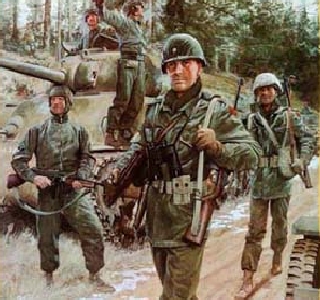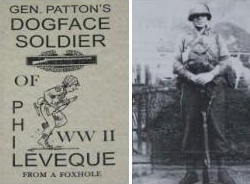
Publisher:
Bonnie King
CONTACT:
Newsroom@Salem-news.com
Advertising:
Adsales@Salem-news.com

~Truth~
~Justice~
~Peace~
TJP
Oct-19-2007 12:30

 TweetFollow @OregonNews
TweetFollow @OregonNews
Officer Fallibility: Infantry Pays Price in Dead and Wounded
Dr. Phillip Leveque Salem-News.comPhillip Leveque has spent his life as a Combat Infantryman, Physician, Toxicologist and Pharmacologist.
 Image courtesy: U.S. Army |
(MOLALLA, Ore.) - One of the most sickening qualities of being in the Infantry was the belief that the superior ranking person was always right. This was disgustingly demonstrated so many times that it is tragic (although it was and is rarely reported in newspapers or other media).
The consequences not only destroyed, physically, the “point of the attacking sword” – The Infantry – but it also destroyed the minds of many of the Infantry and their families – mothers, wives and fatherless children.
This “mental destruction” is called Post Traumatic Stress Disorder or PTSD and has affected a whole “avalanche” of people, especially those mentioned above. The first written reference to PTSD appears to be made in 1900 B.C., by an Egyptian Army Physician who called PTSD a “hysterical reaction to trauma”. This was reported by Veith in 1965, who read and published the Egyptian references. There has been enough recent publicity about PTSD that it should not be necessary for me to belabor the subject.
The Roman Legions may not have had a name for PTSD but they had a solution for it. They called it “decimation”. Legions were based in 10 units. The smallest unit consisted of 10 soldiers. If any of the 10 soldiers in that group became “screwed up” (suffered from PTSD for example) one of the 10 would be killed, a.k.a “decimated”. Whether it was the PTSD victim, or not, is not clear.
Many Prisoners of War, especially prisoners of the Japanese, were also in groups of 10. If one prisoner attempted to escape, or succeeded in escaping, all 10 prisoners would be executed. The Nazi’s had similar systems, although they were even more brutal and extensive. With the Nazi’s, even their Generals were executed.
The system for handling PTSD victims in the U.S. Army was only slightly different. Several American Generals (even 2 and 3 star Generals) were relieved and dismissed in North Africa, Italy, France and Germany. The Generals, Colonels and even Major were usually sent home. For lower ranking officers (mostly Lieutenants) if their squads, platoons or companies were not functioning as Battalion or Regimental Commanders demanded, they were ordered to lead their troops in the attack. First Lieutenants had the highest death and casualty rates, followed by Second Lieutenants. Buck Privates were third.
As privates on the front lines and the “point of the attacking spear”, we didn’t think very highly of what we referred to as the “90 day wonders”, the products of Officer Candidate School. We felt their orders from higher up were going through one ear and out the other without slowing down to process in the brain. We privates paid the price for this.
There were few attacks or assaults that actually went according to plan. Pearl Harbor was one of the first and possibly the worst but our attack in North Africa was almost a failure. Sicily was only a bit better. The Italian invasions were frightful and very expensive because of the incompetence of high level officers. The Invasion of Normandy and the Battle of the Bulge were both saved by the guts and determination of the lowest ranked soldiers and officers. Nobody over the rank of Battalion Commander can claim any pride of accomplishment of either of those battles. I think probably the same can be said for any subsequent war. Especially this one.
******************************************************* You can email your questions to the doctor: newsroom@salem-news.com
You can email your questions to the doctor: newsroom@salem-news.com
 More information on the history of Leveque can be found in his book, General Patton's Dogface Soldier of Phil Leveque about his experiences in WWII. Order the book by mail by following this link: salem-news.com/pages/Dogface_soldier.
More information on the history of Leveque can be found in his book, General Patton's Dogface Soldier of Phil Leveque about his experiences in WWII. Order the book by mail by following this link: salem-news.com/pages/Dogface_soldier.
If you are a World War Two history fan, you don't want to miss it.
Watch for Dr. Phil Leveque's video question and answer segments about medical marijuana with Bonnie King.
Other articles and video segments about medical marijuana on Salem-News.com:
- Oregon Medical Marijuana Doctor Tells All: Q&A Part 6 (VIDEO)
- Medical Marijuana: Treatment for Marijuana Dependence
- Medical Marijuana Medical Conditions
- Medical Marijuana Medical ConditionsConnecticut Governor Vetoes Medical Marijuana Bill
- Medical Marijuana: PTSD Medical Malpractice
- Marine Combat Vet Discusses Iraq, PTSD and Medical Marijuana
- The Most Dangerous Man in Oregon
- Medical Marijuana: What it's About
- Oregon Medical Marijuana Doctor Discusses PTSD Treatment (VIDEO)
- PTSD: Life-Long Challenge For Growing Number of Veterans
- Medical Marijuana: A California Success Story
- Oregon Medical Marijuana Doctor Tells All: Q&A Part 3 (VIDEO)
- Medical Marijuana: The Replacement for Very Dangerous Drugs
- Oregon Toxicologist Says Treatment for PTSD Should Include Cannabis
- Medical Marijuana Doctor Responds to Written Comments (VIDEO) (Originally titled Oregon Medical Marijuana Doctor Tells All: Q&A Part 3)
- Oregon Medical Marijuana Doctor Answers All (VIDEO)
Articles for October 18, 2007 | Articles for October 19, 2007 | Articles for October 20, 2007


Quick Links
DINING
Willamette UniversityGoudy Commons Cafe
Dine on the Queen
Willamette Queen Sternwheeler
MUST SEE SALEM
Oregon Capitol ToursCapitol History Gateway
Willamette River Ride
Willamette Queen Sternwheeler
Historic Home Tours:
Deepwood Museum
The Bush House
Gaiety Hollow Garden
AUCTIONS - APPRAISALS
Auction Masters & AppraisalsCONSTRUCTION SERVICES
Roofing and ContractingSheridan, Ore.
ONLINE SHOPPING
Special Occasion DressesAdvertise with Salem-News
Contact:AdSales@Salem-News.com


googlec507860f6901db00.html
Terms of Service | Privacy Policy
All comments and messages are approved by people and self promotional links or unacceptable comments are denied.
[Return to Top]
©2025 Salem-News.com. All opinions expressed in this article are those of the author and do not necessarily reflect those of Salem-News.com.